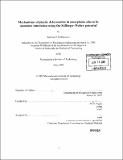Mechanisms of plastic deformation in amorphous silicon by atomistic simulation using the Stillinger-Weber potential
Author(s)
Demkowicz, Michael J. (Michael John), 1977-
DownloadFull printable version (24.76Mb)
Other Contributors
Massachusetts Institute of Technology. Dept. of Mechanical Engineering.
Advisor
Ali S. Argon.
Terms of use
Metadata
Show full item recordAbstract
Molecular dynamics simulation of amorphous silicon (a-Si) using the Stillinger- Weber potential reveals the existence of two distinct atomic environments: one solidlike and the other liquidlike. The mechanical behavior of a-Si when plastically deformed to large strain can be completely described by the mass fraction [phi] of liquidlike material in it. Specifically, samples with higher [phi] are more amenable to plastic flow, indicating that liquidlike atomic environments act as plasticity "carriers" in a-Si. When deformed under constant pressure, all a-Si samples converge to a unique value of [phi] characteristic of steady state flow. Discrete stress relaxations were found to be the source of low-temperature plastic flow in a-Si in deformation simulations by potential energy minimization. These relaxations are triggered when a local yielding criterion is satisfied in a small cluster of atoms. The atomic rearrangements accompanying discrete stress relaxations are describable as autocatalytic avalanches of unit shearing events. Every such unit event centers on a clearly identifiable change in bond length between the two split peaks of the second nearest neighbor shell in the radial distribution function (RDF) of bulk a-Si in steady-state low.
Description
Thesis (Ph. D.)--Massachusetts Institute of Technology, Dept. of Mechanical Engineering, 2005. Includes bibliographical references (p. 205-212).
Date issued
2005Department
Massachusetts Institute of Technology. Department of Mechanical EngineeringPublisher
Massachusetts Institute of Technology
Keywords
Mechanical Engineering.